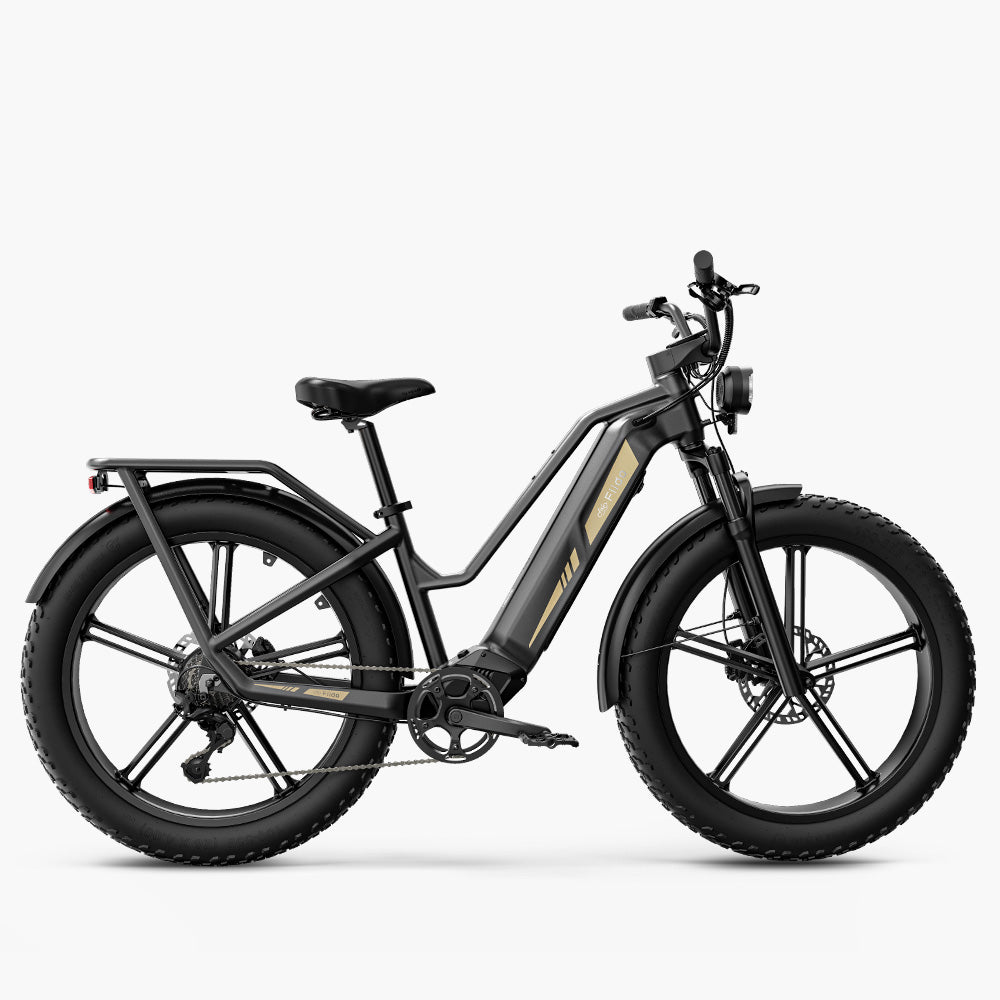Electric bikes combine power and efficiency, especially on mountainous terrain, where an extra boost is invaluable.
Many cyclists choose to convert their mountain bikes into electric ones to gain support during moments of fatigue and to maintain momentum. If you’re one of them, this guide will help you transform your mountain bike into an electric one in a practical and safe way—without spending unnecessary money.

Materials and Tools Needed
First, let’s cover the items you’ll need to convert your mountain bike into an electric version.
Essential components:
-
Hub motor or mid-drive motor
-
Lithium battery
-
Controller
-
Pedal-assist sensor (PAS)
-
Control display
Tools required:
-
Wrenches
-
Screwdrivers
-
Cable cutters
-
Cable ties
You’ll also need to be very careful, patient, and ideally have a passion for or some basic mechanical skills to handle the required assembly. Although it may seem complicated, doing it yourself can save you quite a bit of money.
Choosing the Right Power System
A crucial step is selecting the type of motor you’ll use for the conversion. There are two main types: hub motors, installed in the wheels, and mid-drive motors, which are mounted at the crankset.
Mid-drive motors typically offer better performance on hills and a more balanced center of gravity, while hub motors are easier to install and less expensive.
Battery Capacity
When choosing your battery, you should first understand its capacity, measured in amp-hours (Ah).
The higher the capacity, the longer your e-bike will last on a single charge. For mountainous or long-distance rides, a battery with at least 10–12 Ah is recommended.
Removing Original Components
Before installing the electric system, carefully remove the rear wheel and any components that may interfere, such as the brakes or derailleur, depending on where you’ll mount the motor.
Installing the Electric System
Once you’ve removed the necessary components from your mountain bike, gathered all the tools, and chosen your motor and battery, it’s time to begin the installation.
Step-by-step process:
Battery installation:
Start by selecting a suitable spot on the bike frame to mount the battery—typically the down tube, which provides better balance. Secure all cables neatly with cable ties to prevent tangling or interference.
Controller and sensors:
Mount the controller in a protected area such as under the seat or along the down tube. Connect the pedal-assist sensors and make sure the system is properly synchronized to activate electric assistance when pedaling begins.

Time for a Test Ride
Once everything is installed, take a complete test ride to ensure the motor, battery, and controller are working properly. Verify that the bike responds correctly to the pedal-assist sensors and that the assistance engages smoothly.
Common Issues and How to Solve Them
When converting a mountain bike into an e-bike, certain problems may arise that affect system performance. Below are some common issues and their solutions:
1. Motor Doesn’t Activate
Problem: Often caused by loose or incorrect cable connections during installation.
Solution: Disconnect and carefully reconnect all cables, making sure each connector is in the correct place. Use cable ties to secure connections and prevent them from loosening during rides.
Problem: If the battery is not charged or is defective, the motor won’t run.
Solution: Fully charge the battery before use. If it doesn’t charge, check the charger and charging port for faults. Contact the manufacturer if the battery appears to be defective.
2. Loss of Power or Low Speed
Problem: A nearly depleted battery may not deliver enough power, resulting in reduced speed.
Solution: Always charge the battery fully before each ride. If it doesn’t hold charge as it used to, it may be nearing the end of its lifecycle. Lithium batteries typically last 500–1,000 charge cycles before losing significant capacity.
Problem: The motor may overheat after extended use or on steep, rough terrain.
Solution: Allow the bike to cool before riding again. If the problem persists, the motor may need servicing.
3. Pedal-Assist Sensor Not Responding
The PAS sensor activates the motor when you start pedaling, but may fail if misaligned or improperly connected.
Ensure the sensor is installed close to the crankset with magnets properly aligned. Misalignment can prevent the sensor from detecting pedal movement.
Solution: Adjust the sensor and magnet alignment. Check for loose parts or debris that might interfere with the signal.
4. Battery Not Charging
This can be a frustrating issue with several possible causes.
Dirty or damaged charging port: Dirty or corroded ports can prevent charging.
Solution: Clean the battery and charger contacts with a dry cloth. Ensure there are no obstructions. Replace damaged ports if needed.
Defective charger:
Solution: Test the charger with another battery. If it doesn’t work, replace it. If the battery still won’t charge, the battery itself may be at fault.
5. Control Display Not Responding
Displays that show speed, battery level, and assist modes may fail due to poor connections or electrical issues.
Solution: Check all connections between the display and the controller. Ensure no wires are damaged or disconnected.
Safety Precautions
When using your modified electric bike, follow these safety tips:
-
Always wear a helmet and proper protective gear
-
Avoid dangerous terrain unless you’re experienced with electric riding
-
Regularly inspect the electric system to prevent failures
- If you're unsure about any part of the installation or usage, it is strongly recommended to consult a qualified technician or professional
During the modification process, while you can save money, there are also safety risks—especially if the battery or motor is not installed correctly, which could lead to accidents.
For those who prefer to enjoy electric riding safely and worry-free, buying a pre-assembled electric bike may be a better choice. This guarantees optimal performance and includes after-sales support from the manufacturer.
Recommended Fiido Electric Bikes
Fiido X: Lightweight and efficient, perfect for those seeking a reliable option for both urban and outdoor use.
Fiido Titan: Ideal for electric mountain bikes, this electric bike delivers strong climbing ability and long-lasting battery life—perfect for off-road routes.
Fiido Titan Robust Cargo Electric Bike
A powerhouse with a 347 km range and 4-piston brakes, ideal for hunting and fishing trips.
Reminder: Prices are subject to the product detail page ,some earlier card details may have been updated.
Conclusion
Converting a mountain bike into an electric one is a great option for those seeking more versatility in their rides. By following these steps and selecting the right components, you can enjoy a custom riding experience tailored to your needs and budget—or simply opt for the Fiido Cross Electric Bike for a convenient, high-performance solution.














